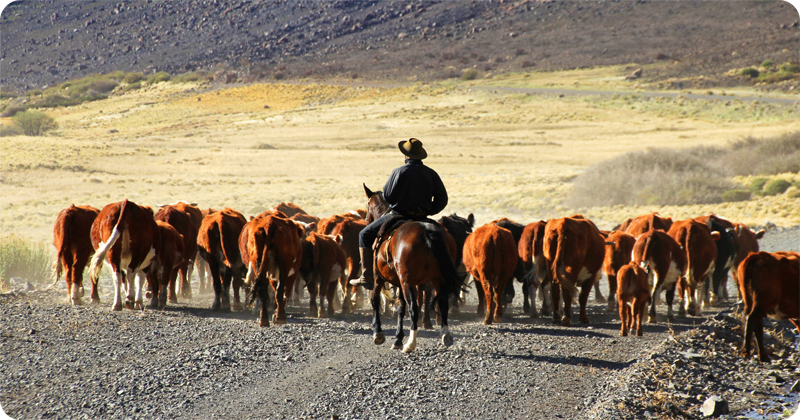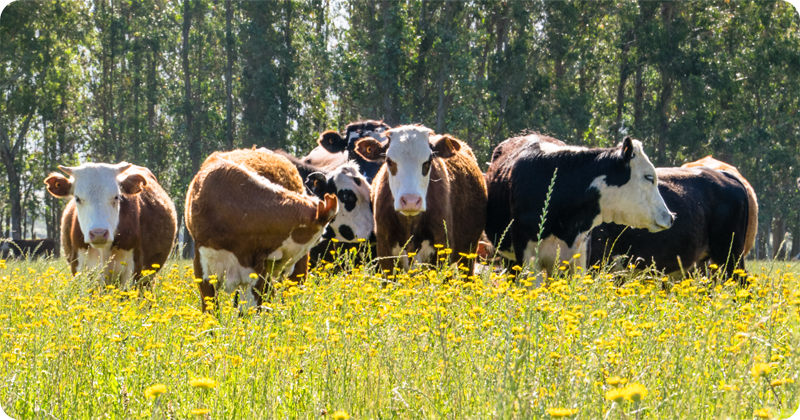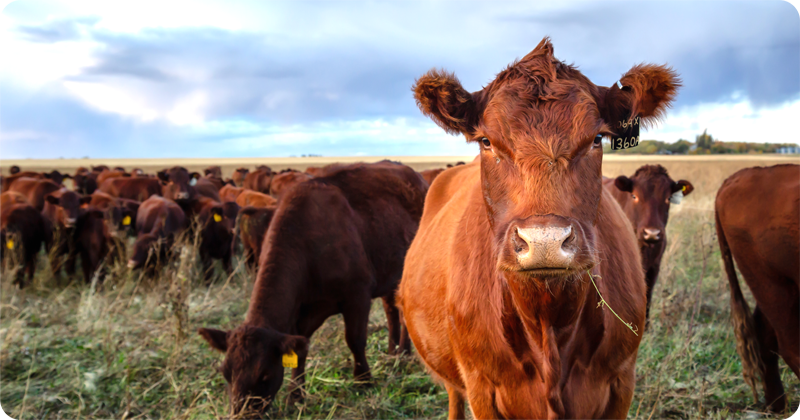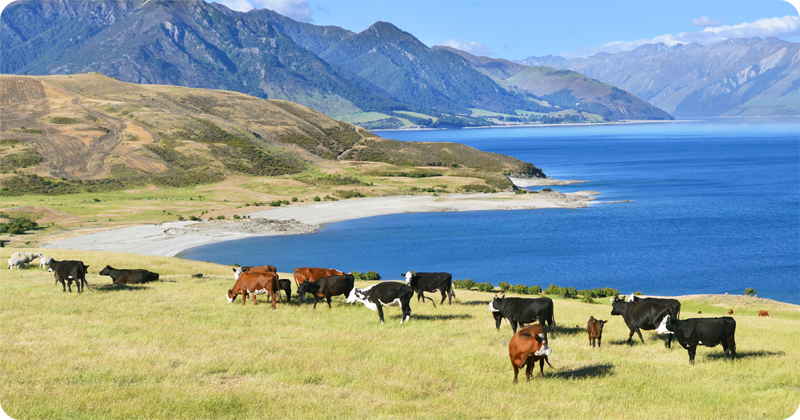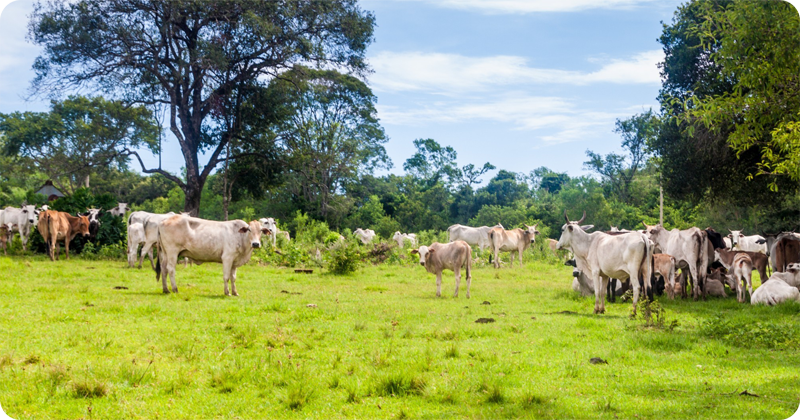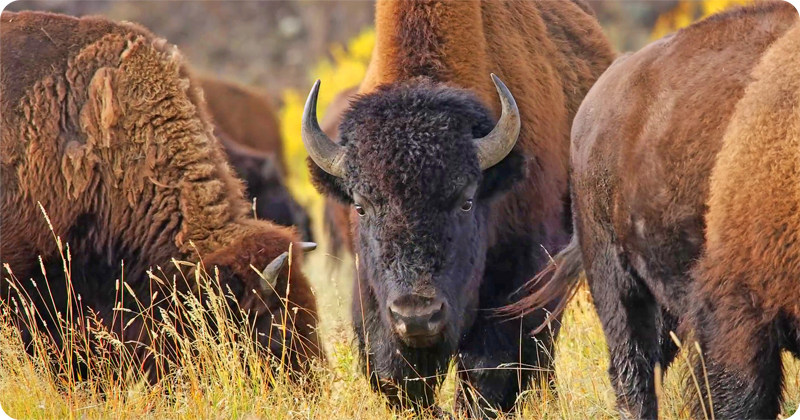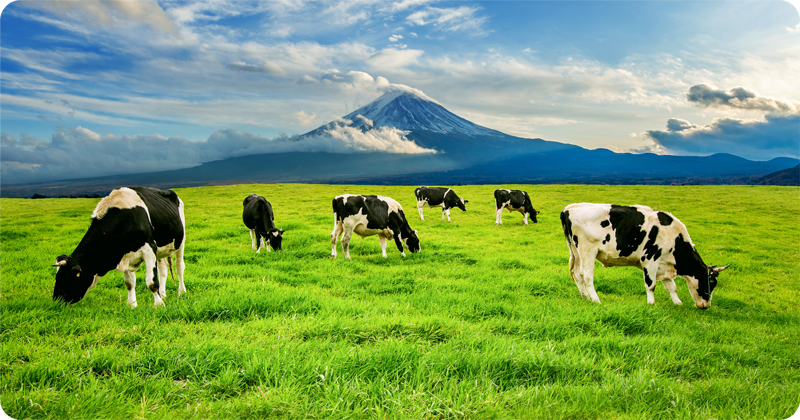
AUSTRALIA
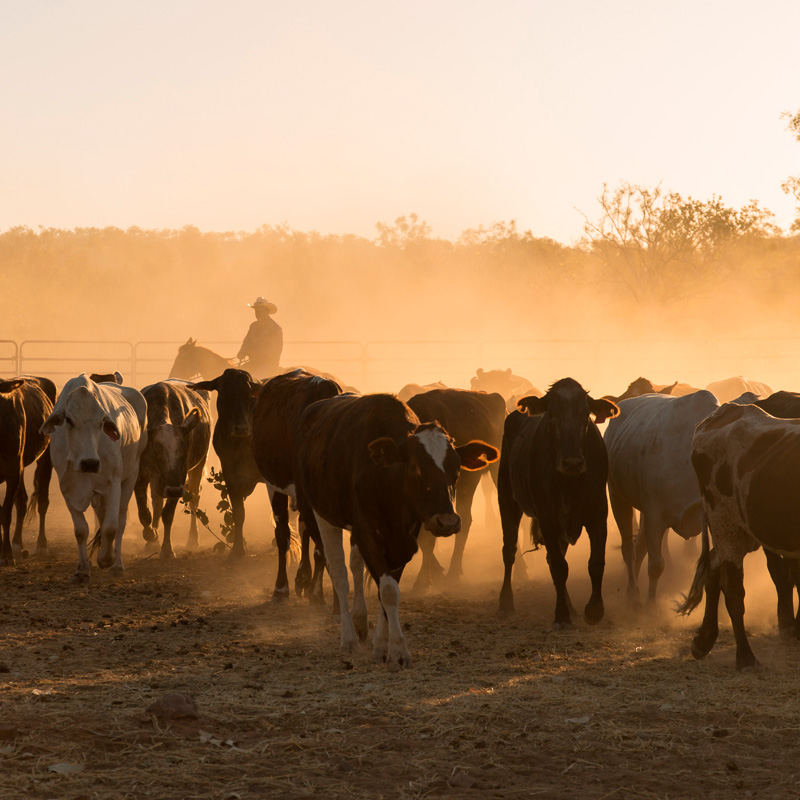
THE ORIGINS
Australia makes you think of a faraway and unspoilt land where nature still dominates. When you think about Australian cuisine, the first thing that comes to mind is the meat. As a matter of fact, Australia is known all over the world for its high quality beef: very aromatic, tasty and with a clear “core” of fat. Tender and juicy thanks to the thin fibres and a high level of marbling.
The cattle are reared with a production system that is based on natural foods such as grass from pastures. The most prized and renowned Australian meats are Black Angus and the highly prized Wagyu.
The charm that this country arouses, combined with the goodness of its meat, are the perfect mix to create recipes with an exotic flavour.
The cattle are reared with a production system that is based on natural foods such as grass from pastures. The most prized and renowned Australian meats are Black Angus and the highly prized Wagyu.
The charm that this country arouses, combined with the goodness of its meat, are the perfect mix to create recipes with an exotic flavour.
|
|
|||||||||||||||
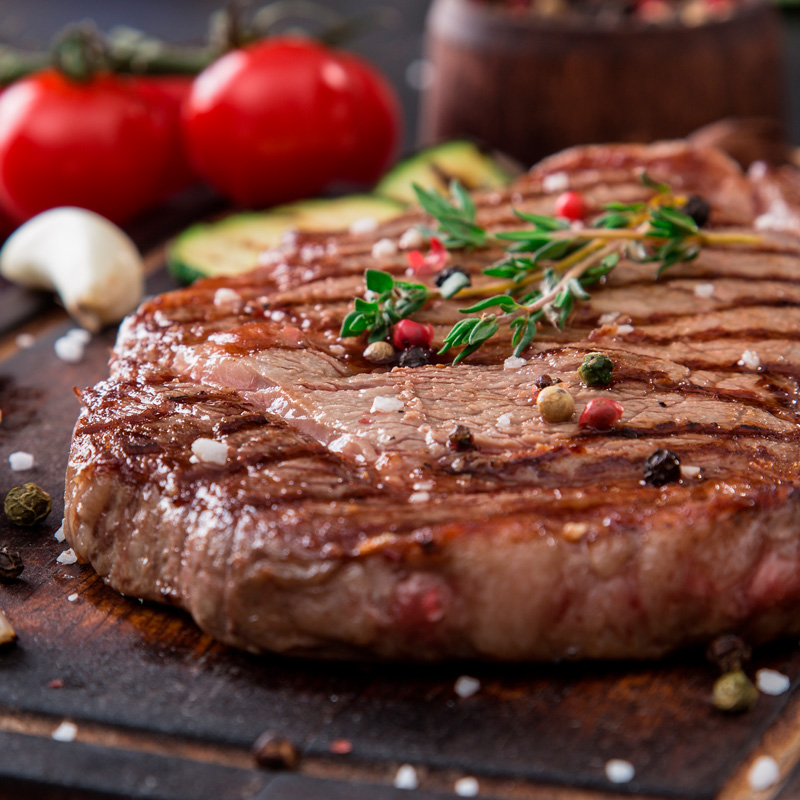
ENTRECÔTE
Very fine cut obtained from the sirloin of Australian boneless beef. Thanks to the natural way of rearing, based on natural foods such as pasture grass, the meat is particularly tender, tasty and with very little fat, can be of variable thickness and lends itself to many different preparations: grilled, baked or pan. In France, the native land of this preparation, it is often accompanied by sauces of various kinds.
Preparation tips
Cooking mode Remove the packaging. Once the package is opened, it is recommended to oxygenate the product for at least 10 minutes so that it regains the typical colour of fresh meat.
Entrecôte with wine sauce
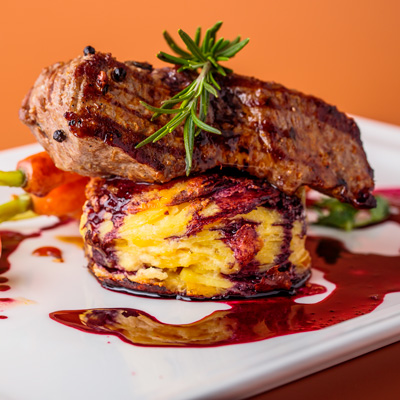 Cook the entrecotes in a well oiled pan for 4 minutes on each side.
Serve with a reduction of red wine previously so prepared. Add thyme, sage, rosemary, shallot, bay leaves, juniper berries and cloves to the red wine; cook over high heat until the volume is halved. Remove the flavours and create a roux by adding 40 g of butter and a couple of spoonfuls of flour to the reduction.
Cook the entrecotes in a well oiled pan for 4 minutes on each side.
Serve with a reduction of red wine previously so prepared. Add thyme, sage, rosemary, shallot, bay leaves, juniper berries and cloves to the red wine; cook over high heat until the volume is halved. Remove the flavours and create a roux by adding 40 g of butter and a couple of spoonfuls of flour to the reduction.
FILLET STEAK
By far, the softest and most valuable cut. From the lumbar area, the cut involves a muscle almost never trained by the animal, hence its unmistakable tenderness.
Very small in size, it is a single piece that can be divided into three parts, each perfect for different consumptions. It can be used for making steaks, tartare, carpaccio, chateaubriand, tournedos and filets mignon.
Preparation tips
Cooking mode Remove the packaging. Once the package is opened, it is recommended to oxygenate the product for at least 10 minutes so that it regains the typical colour of fresh meat.
Fillet with lard and red pepper
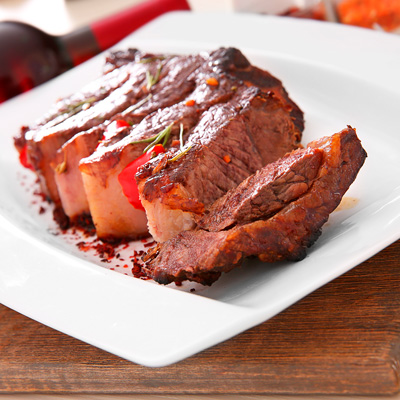 Lay the slices of lard next to each other on a cutting board. Wrap the fillets in the lard and stir in a lot of rosemary and red pepper berries.
Lay the slices of lard next to each other on a cutting board. Wrap the fillets in the lard and stir in a lot of rosemary and red pepper berries. Place in a lightly oiled baking tray and bake in a preheated oven at 200°C for 25 minutes.
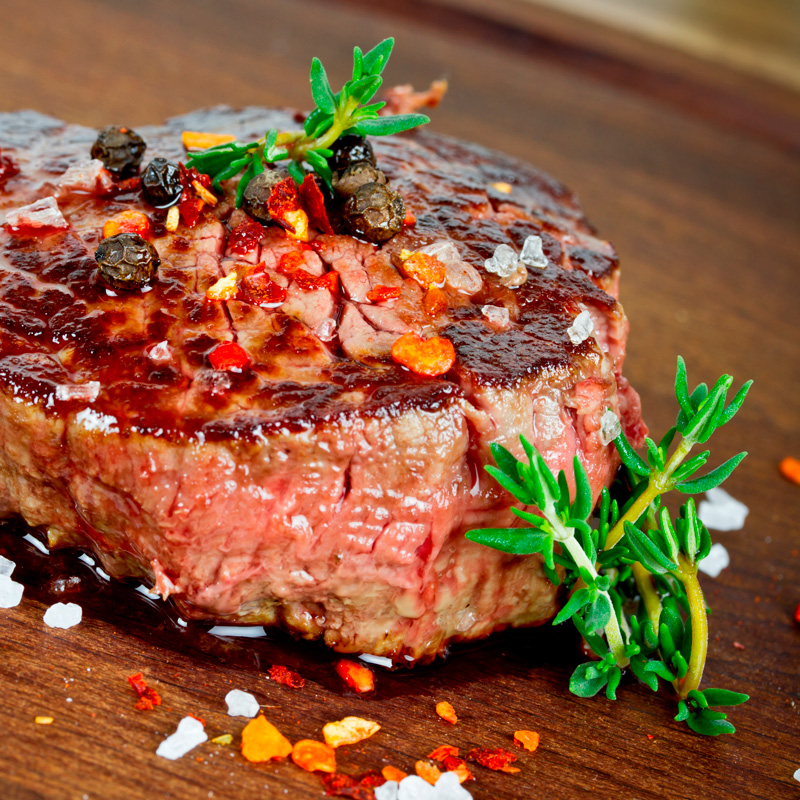
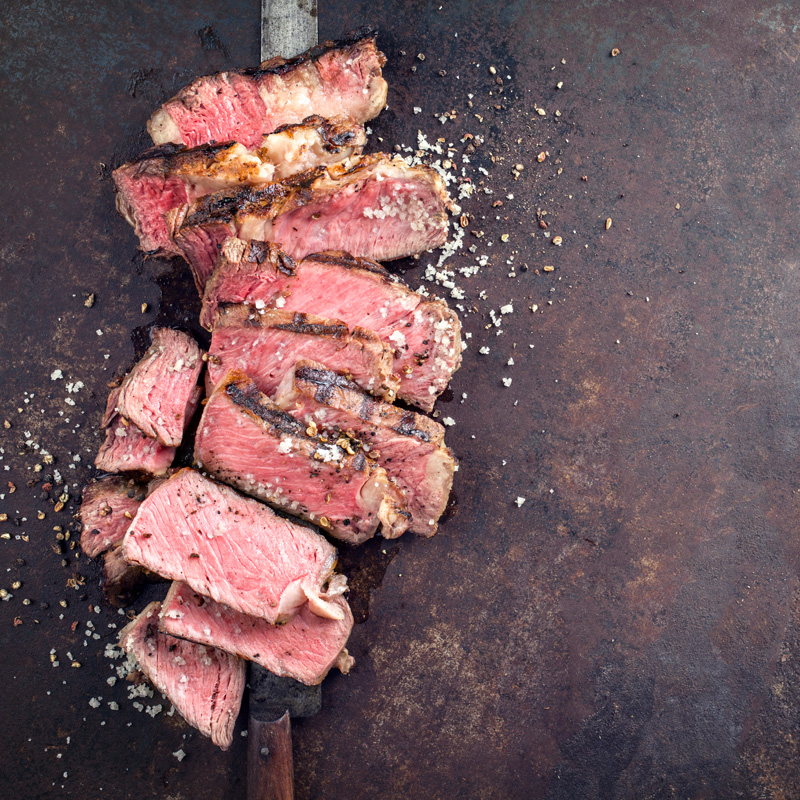
ROAST-BEEF
Top quality cut, thin and wrapped in a thin strip of fat. It includes all - or almost all - the dorsal area of the animal. If with the bone, it is called rib eye, while without the bone, it provides sirloin steak. Suitable for roasting and for the preparation of the typical English roast beef.
Preparation tips
Cooking mode Remove the packaging. Once the package is opened, it is recommended to oxygenate the product for at least 10 minutes so that it regains the typical colour of fresh meat.
Baked Roast Beef
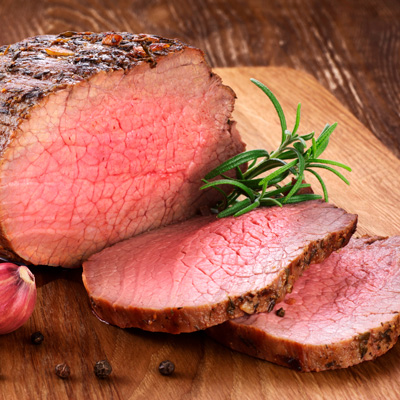 Tie the piece of meat with kitchen string and place it on the grill of the oven preheated to 250°C. For rare cooking, it takes 30 minutes per kg of meat, for an average cooking time of 40-45 minutes. 5 minutes before the end, remove from the oven and add salt and pepper.
Tie the piece of meat with kitchen string and place it on the grill of the oven preheated to 250°C. For rare cooking, it takes 30 minutes per kg of meat, for an average cooking time of 40-45 minutes. 5 minutes before the end, remove from the oven and add salt and pepper.Lower the oven temperature to 200°C and put the meat back on for another 5 minutes so that a crust forms on the outside.
RUMP
A cut of rather fine beef that joins the thigh and sirloin. Low fat, tender and moderately digestible, the rump is extremely versatile in the kitchen: ideal for grilling, in the pan or in the oven, it can also be transformed into quality grinded meat. Less suitable for long cooking (boiled, braised and stewed).
Preparation tips
Cooking mode Remove the packaging. Once the package is opened, it is recommended to oxygenate the product for at least 10 minutes so that it regains the typical colour of fresh meat.
Rump with Parmesan cheese
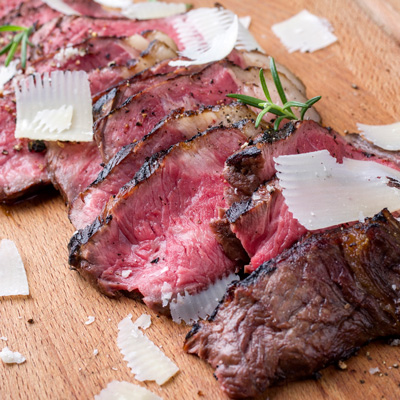 Cut the piece of rump deeply and in several places and insert in it flakes of grain. Salt and pepper. Flour the piece of meat and place it in a saucepan with a knob of butter and 3 tablespoons of oil. Brown over a low flame and fade with red wine vinegar. Cook for a couple of hours over a low heat and cover adding some broth, from time to time.
Cut the piece of rump deeply and in several places and insert in it flakes of grain. Salt and pepper. Flour the piece of meat and place it in a saucepan with a knob of butter and 3 tablespoons of oil. Brown over a low flame and fade with red wine vinegar. Cook for a couple of hours over a low heat and cover adding some broth, from time to time.Serve with a sauce obtained by adding cream to the cooking juices.
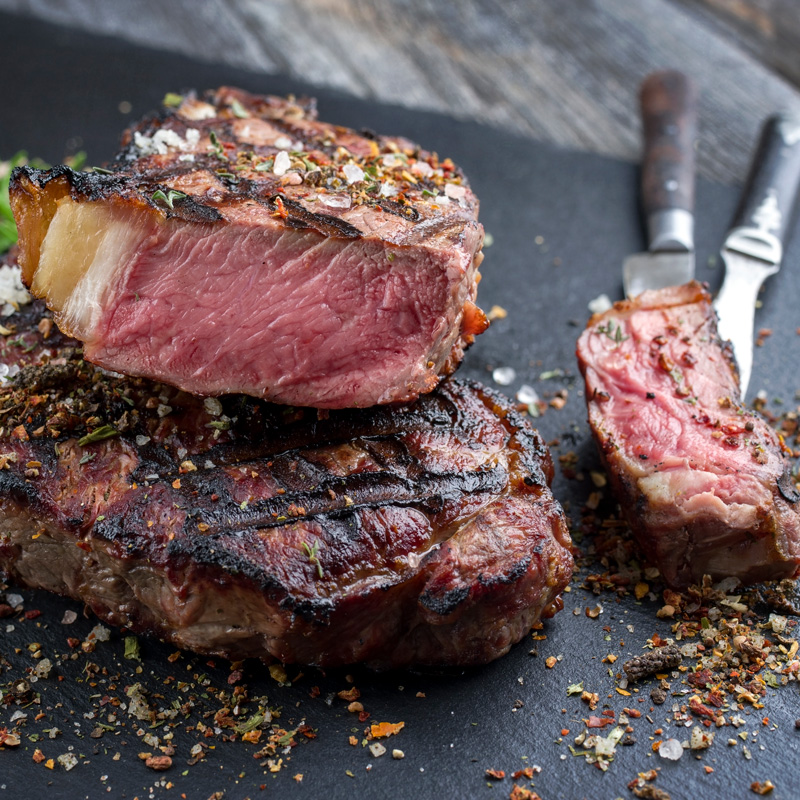
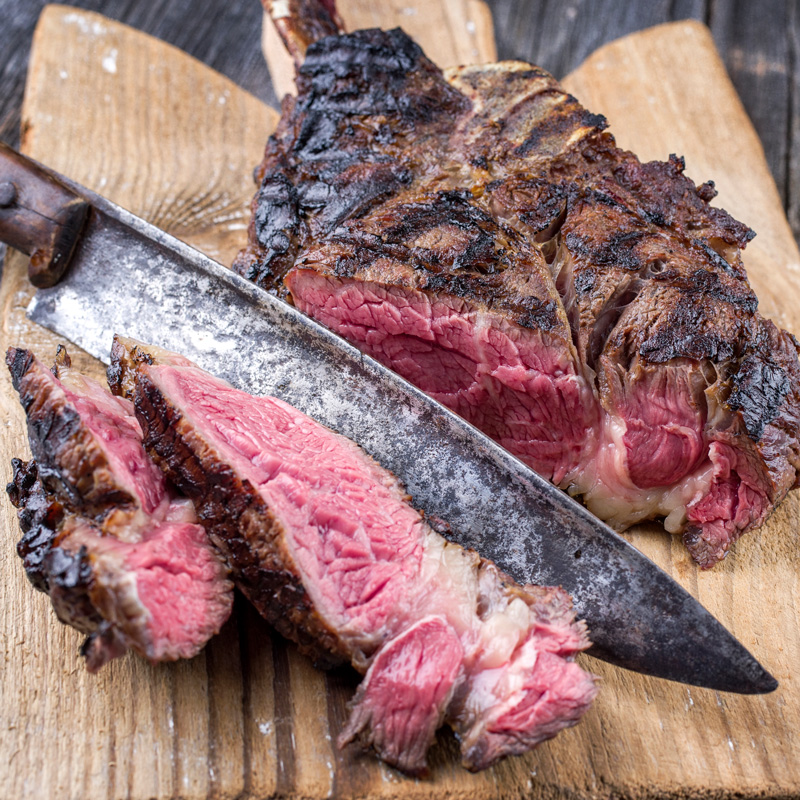
CÔTE DE BOEF
Top class beef steak with bone, taken from the main piece of the animal. The natural coating of fat caramelises during cooking, making the meat tender and with an exceptional flavour. Excellent in a pan or grilled, the important thing is to cut the steak on both sides before cooking.
Preparation tips
Cooking mode Remove the packaging. Once the package is opened, it is recommended to oxygenate the product for at least 10 minutes so that it regains the typical colour of fresh meat.
Côte de boef on a bed of potatoes with whipped butter
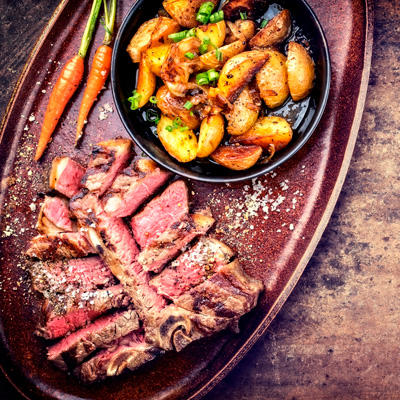 In a greased frying pan, sauté 1kg of sliced potatoes, a couple of parsnip roots, a knob of butter, salt, pepper and thyme. Put everything in a pan and bake in the oven at 170°C for 40 minutes.
In a greased frying pan, sauté 1kg of sliced potatoes, a couple of parsnip roots, a knob of butter, salt, pepper and thyme. Put everything in a pan and bake in the oven at 170°C for 40 minutes. Roast the meat in a hot pan for 3-4 minutes on each side; place the pan in the oven at 200°C for 20 minutes and turn the meat occasionally.
Serve on a bed of potatoes with a tablespoon of whipped butter flavoured with garlic, herbs, lemon, salt and pepper.
T-BONE STEAK
A cut from the sirloin of veal or heifer.
It is a cut of 1-1.5 kg, about 5-6 cm thick, with a “T” shaped bone at the center, with the fillet on one side and the sirloin on the other.
It is cooked on the ember grill or traditionally grilled and served very rare. It is essential not to pierce or season the steak. It is advisable to turn the steak only once.
It is a cut of 1-1.5 kg, about 5-6 cm thick, with a “T” shaped bone at the center, with the fillet on one side and the sirloin on the other.
It is cooked on the ember grill or traditionally grilled and served very rare. It is essential not to pierce or season the steak. It is advisable to turn the steak only once.
Preparation tips
Cooking mode Remove the packaging. Once the package is opened, it is recommended to oxygenate the product for at least 10 minutes so that it regains the typical colour of fresh meat.
Baked Florentine steak
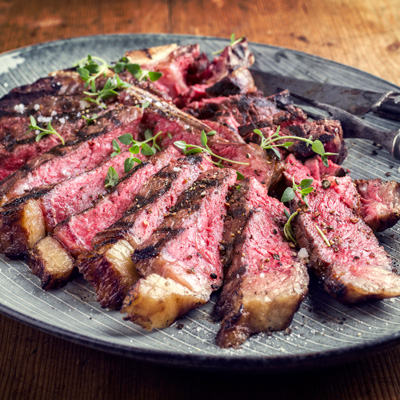 Heat the oven to 200°C and rub the meat with garlic and thyme.
Heat the oven to 200°C and rub the meat with garlic and thyme.Put some oil in a low pan and brown the rib on both sides. Put the frying pan in the hot oven, cook for 15 minutes (rare cooking), a few more minutes (well done). Remove from the oven and let rest a few minutes covered with aluminium foil. Sprinkle with salt and black pepper.
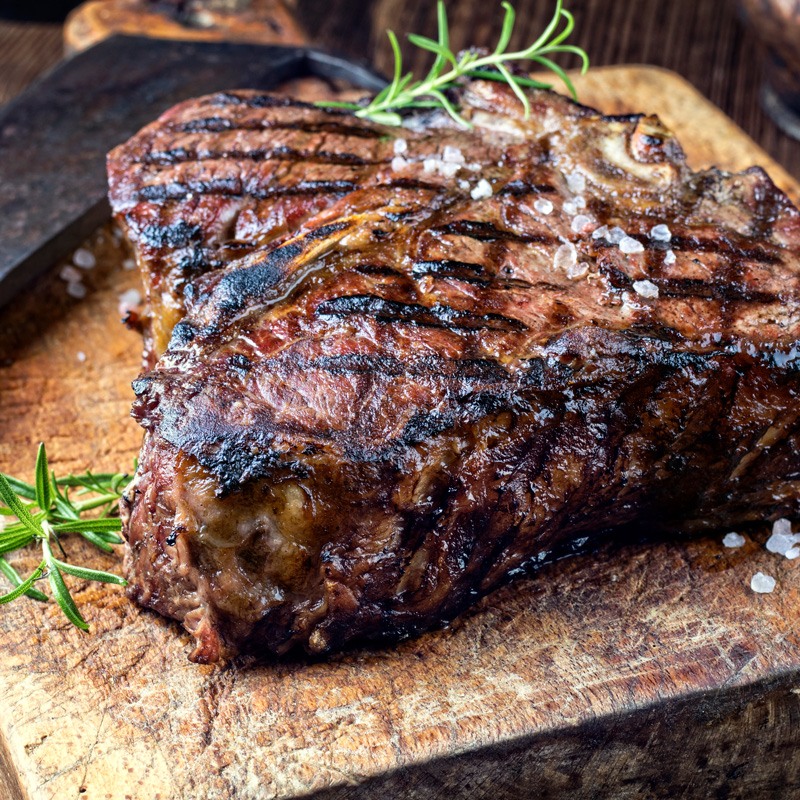
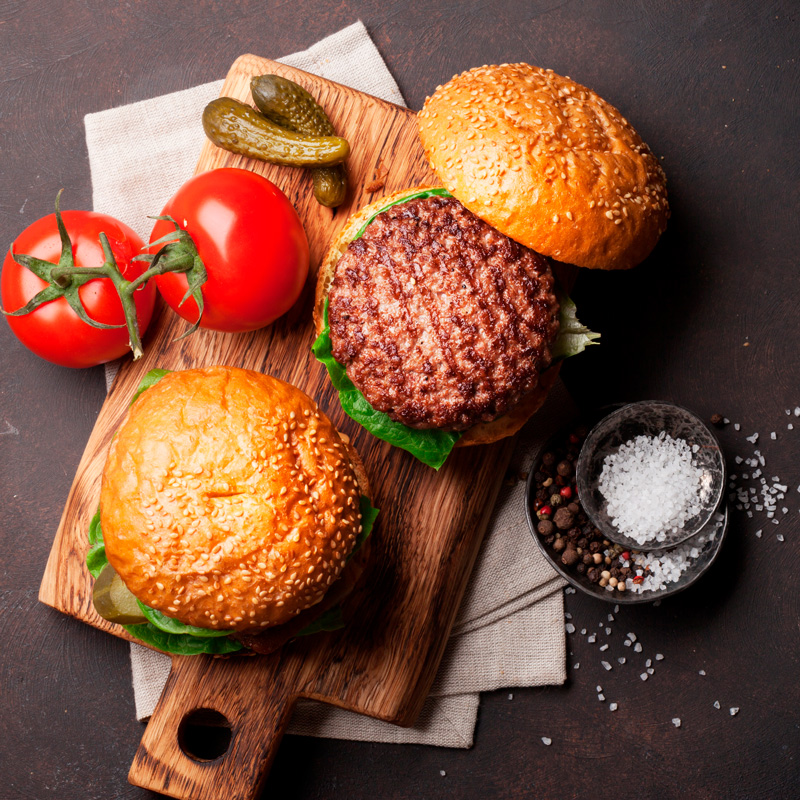
HAMBURGER
Famous dish of minced and pressed meat. The different types of meat used must create a perfect mix between fat and firm meat in order to obtain the right balance between taste and juiciness.
It is mainly cooked in a frying pan or on the griddle and is eaten in a simple way or inside a sandwich with the addition of tomato, lettuce, cheese and sauces at will.
Preparation tips
Cooking mode Remove the packaging. Once the package is opened, it is recommended to oxygenate the product for at least 10 minutes so that it regains the typical colour of fresh meat.
Queen’s Burger
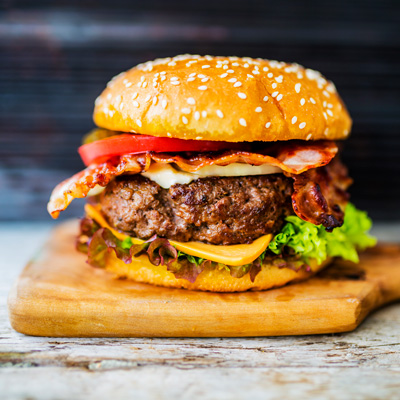 Grill the hamburger on a hot plate and prepare an omelette with Parmesan cheese.
Toast the bread and stuff it with mayonnaise, a thin slice of omelette, a slice of provola, hamburger, a slice of boiled potato, browned onion, pickled cucumbers and mayonnaise.
Grill the hamburger on a hot plate and prepare an omelette with Parmesan cheese.
Toast the bread and stuff it with mayonnaise, a thin slice of omelette, a slice of provola, hamburger, a slice of boiled potato, browned onion, pickled cucumbers and mayonnaise.
ANGUS
Very tender, juicy and savoury, Angus meat is smooth, compact and with thin filaments of fat which, once dissolved in the cooking process, release an intense aroma and enhance its softness. Rich in precious nutrients, 100 grams of Angus provide only 124 kcal (82% protein and 18% fat). A delicious and genuine dish. Simple cooking methods (pan, plate, grill) are the best way to enhance and appreciate the noble qualities of the product.
Preparation tips
Cooking mode Remove the packaging. Once the package is opened, it is recommended to oxygenate the product for at least 10 minutes so that it regains the typical colour of fresh meat.
Sliced angus steak with cherry tomatoes and rocket
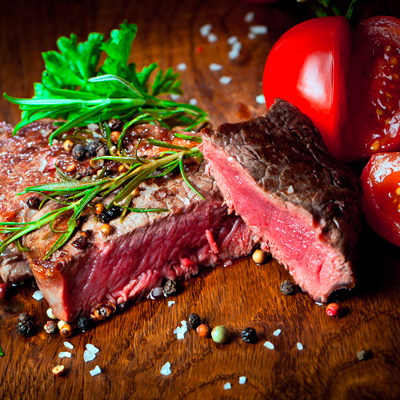 Heat a cast iron pot and lay the meat on it, cooking it for 5 minutes on each side.
Remove the meat from the heat and, after having it cooled, reduce it to oblique slices of about 2 cm. On a serving plate create a bed of rocket and cherry tomatoes on which to place the slices of meat. Season with salt and pepper and sprinkle with raw extra virgin olive oil.
Heat a cast iron pot and lay the meat on it, cooking it for 5 minutes on each side.
Remove the meat from the heat and, after having it cooled, reduce it to oblique slices of about 2 cm. On a serving plate create a bed of rocket and cherry tomatoes on which to place the slices of meat. Season with salt and pepper and sprinkle with raw extra virgin olive oil.
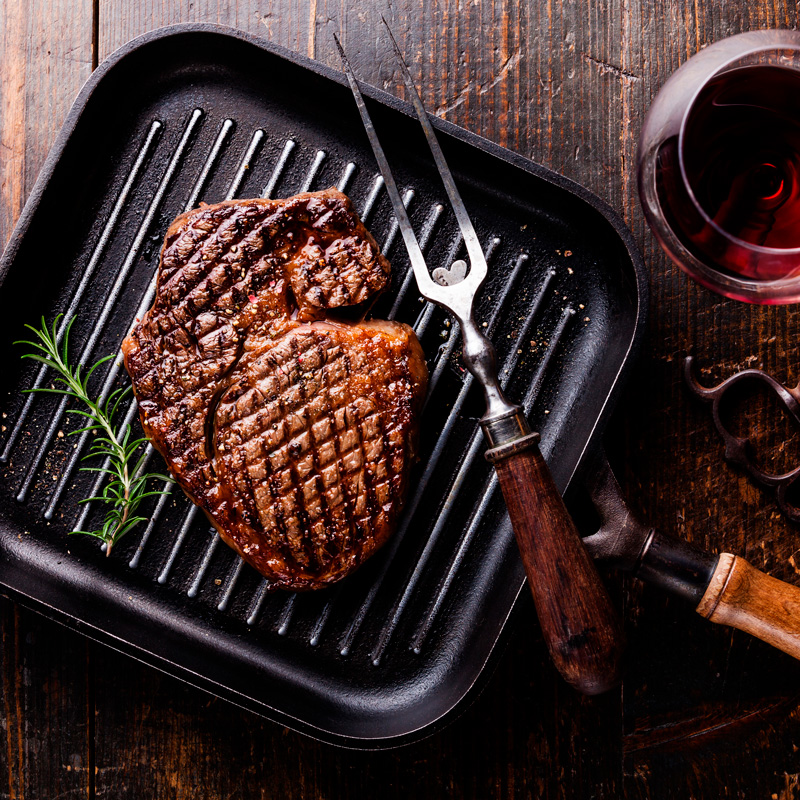
 ARGENTINA
ARGENTINAArgentina produces some of the best meats in the world for taste and tenderness. The goodness and
peculiarities of Argentine meat can be traced back to the completely natural method with which the beef is reared. Left to
live in the wild in the endless pampas, the animals feed exclusively on grass. This type of farming favours the production
in the animal of substancesthat contribute to making the meat soft, tasty and healthy.
 URUGUAY
URUGUAYUruguay produces a meat that, among other countries in South America, is distinguished by quality.
The excellence of the product is based on the type of farming. The animals, in fact, live in the open air in total harmony
with the environment. The result is a meat with a refined taste, high nutritional value, guarantee of origin and
authenticity. Uruguayan meat is rich in Omega 3, Vitamin E (antioxidants) and has low fat levels.
 BRAZIL
BRAZILBrazil, the world leading beef exporter, is increasingly highlighted by the quality of its meat. A
tender and tasty meat obtained through production systems in temperate, tropical pastures and intensive systems that
produce the most distinct quality specifications.
The healthy and natural diet of the animals guarantees the authenticity and safety of the meat and the preservation of the
environment.
 USA
USAAmerican meat is famous for its high level of marbling, i.e. the uniform spread of fat. This
particular characteristic makes the meat soft, juicy and with a strong and tasty taste.
Cattle are reared in a totally natural way and fed on a maize-based vegetarian diet without the use of supplementary hormones, growth promoters or additives.
Cattle are reared in a totally natural way and fed on a maize-based vegetarian diet without the use of supplementary hormones, growth promoters or additives.
 NEW
ZEALAND
NEW
ZEALANDNew Zealand meat is internationally recognized for its high quality, tenderness and delicious
taste.
The animals grow in an exceptional environment: in the open air, on rich and abundant pastures overlooking the Pacific
Ocean and with a mild and constant climate all year round. They are also subject to regular and very strict quality
controls. The result is a lean, nutritionally rich and high quality meat.
 PARAGUAY
PARAGUAYParaguay is one of the world leading beef exporters.
The excellence of Paraguayan meat is based on the type of farming. The animals, in fact, live in the open air in total harmony with the environment.
The meat is known for its marbled appearance, excellent tenderness and flavour characteristics, unbeatable taste and quality.
The excellence of Paraguayan meat is based on the type of farming. The animals, in fact, live in the open air in total harmony with the environment.
The meat is known for its marbled appearance, excellent tenderness and flavour characteristics, unbeatable taste and quality.
 CANADA
CANADACanada, one of the world's leading beef producers, selects the best breeds and raises them in a
pristine natural environment to provide the market with healthy, high-quality beef.
Canada's cool climate is an optimal habitat for animals. Canadian meat is known for its marbled appearance, excellent tenderness and flavour characteristics, unbeatable taste and quality.
Canada's cool climate is an optimal habitat for animals. Canadian meat is known for its marbled appearance, excellent tenderness and flavour characteristics, unbeatable taste and quality.
 JAPAN
JAPANKobe beef is a Japanese delicacy obtained from wagyu, a black mantle cattle of the Tajima breed.
Kobe meat is tender, very tasty and has an excellent taste. The merit lies in the marbling of the meat, which has a high
percentage of fat distributed evenly.
The registered trademark and the strict parameters imposed to define "Kobe's" meat, have made it a precious niche product,
renowned, expensive and sought after throughout the world.


